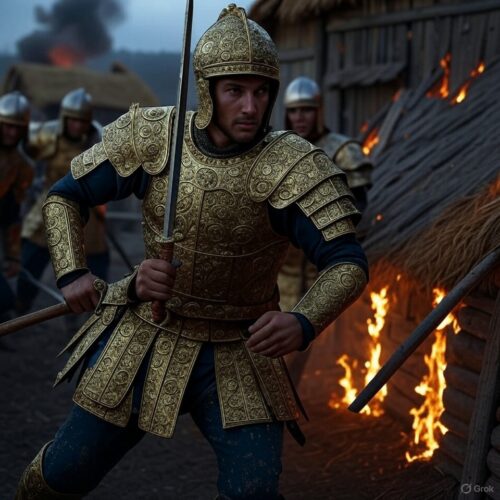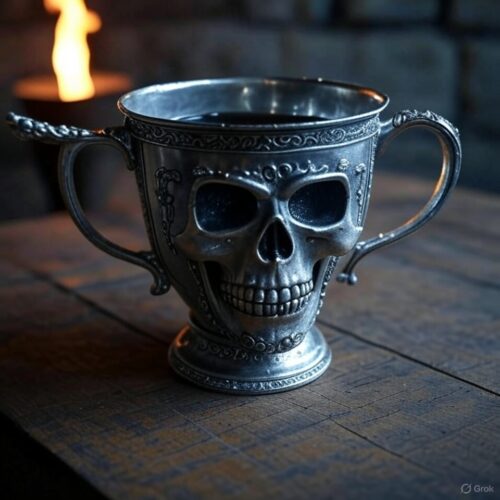Picture this: a gleaming army clad in armor, banners fluttering in the wind, marching triumphantly into an enemy capital. The air is thick with the scent of victory—gold and silver treasures piled high, buildings smoldering from the torch’s kiss. On July 23rd, 811 AD, Byzantine Emperor Nikephoros I stood at the pinnacle of such a moment, having just seized the Bulgarian capital of Pliska. His enemies were scattered, their wealth was his, and the world seemed to bend to his will. But history, ever the trickster, had a twist in store. Within days, this dazzling victory crumbled into one of the most humiliating defeats of the era, leaving behind a tale that’s both a historical gem and a goldmine of wisdom for us today.
Welcome to a journey through the dusty annals of the early 9th century, where empires clashed, ambition soared, and a single misstep turned glory into a grim legend. This isn’t just a story of swords and skulls—it’s a lesson in strategy, humility, and the fine art of knowing when to stop. Over the next 3000+ words, we’ll dive deep into the historical nitty-gritty of Nikephoros’s campaign, unravel why it all went wrong, and then flip the script to show how this ancient blunder can turbocharge your life in the modern world. Expect vivid details, a dash of fun, and a hefty dose of motivation to cap it all off. Plus, stick around for five ultra-realistic images that’ll transport you straight to 811 AD and back again.
—
## The Stage is Set: Byzantium and Bulgaria in 811 AD
To get the full scoop on July 23rd, 811, we need to rewind a bit and paint the picture of the world Nikephoros and his Bulgarian rival, Khan Krum, inhabited. The Byzantine Empire, often called the Eastern Roman Empire, was the heavyweight champion of the medieval Mediterranean. By 811, it was a sprawling realm stretching from southern Italy to the Balkans, with its glittering capital, Constantinople, as the jewel in its crown. This wasn’t the Rome of Caesar and togas—think more along the lines of a sophisticated, Greek-speaking powerhouse with a knack for bureaucracy, dazzling mosaics, and a military that could make lesser kingdoms tremble.
Enter Nikephoros I, who’d been emperor since 802. He wasn’t born with a silver spoon—before the throne, he was a finance minister, a bean-counter turned warrior-king. When he ousted Empress Irene in a coup, he inherited an empire battered by internal strife and external threats. Nikephoros was all about action—he wanted to flex Byzantine muscle, refill the treasury, and remind everyone who was boss. His eyes soon turned north, to the rugged Balkans, where a rising power was giving him serious headaches: the Bulgarian Khanate.
The Bulgarians weren’t just some ragtag tribe. Under Khan Krum, who took the reins around 803, they were forging a state to be reckoned with. Krum was a force of nature—cunning, brutal, and a master of war. His capital, Pliska, wasn’t a sleepy village but a sprawling fortress-city, complete with stone walls, wooden palaces, and a treasury stuffed with loot from years of raids. The Bulgarians had been needling the Byzantines for decades, raiding border towns and clashing with imperial garrisons. By 811, Nikephoros had had enough. He decided it was time to teach Krum a lesson he’d never forget.
—
## The Campaign Begins: A March to Glory
Spring 811 saw Nikephoros muster a massive army—some say 60,000 strong, though that’s probably a medieval exaggeration. Picture a sea of soldiers: grizzled veterans in chainmail, cavalry on snorting horses, and a baggage train groaning with supplies. This wasn’t a quick raid; it was a full-on invasion. Nikephoros’s plan was simple but bold—smash into Bulgaria, burn Pliska to the ground, and leave K + Krum begging for mercy.
The Byzantines crossed the border in early summer, their banners snapping in the breeze as they trudged through the Balkan foothills. Krum, no fool, knew he couldn’t slug it out toe-to-toe with this juggernaut. Instead, he played it smart—his scouts shadowed the invaders, picking off stragglers and torching fields to starve them out. It was guerrilla warfare, medieval style, and it slowed Nikephoros down. But the emperor wasn’t fazed. He kept pushing, his eyes locked on Pliska.
By mid-July, the Byzantines were closing in. Krum tried to buy time, sending envoys with peace offers—tribute, hostages, the works. Nikephoros laughed them off. He smelled blood and wasn’t about to let his prey slip away. On July 20th, his army camped within striking distance of Pliska. The stage was set for the big showdown.
—
## July 23rd, 811: The Sack of Pliska
Then came the day—July 23rd, 811. The Byzantine war machine roared to life. Pliska’s defenses were no match—Krum had pulled most of his troops back, leaving only a skeleton crew to hold the line. The city’s wooden ramparts buckled under the onslaught. Byzantine soldiers poured in, swords flashing, torches blazing. By midday, Pliska was theirs.

What followed was chaos with a capital C. Nikephoros let his troops loose—Pliska became a bonfire of looting and destruction. Palaces were ransacked, granaries emptied, and Krum’s treasury hauled off in carts. Gold coins spilled into the dirt, silver goblets glinted in the sun, and soldiers stuffed their tunics—with loot. Nikephoros strutted through the carnage, basking in his triumph. For a fleeting moment, he was untouchable.
But here’s where the plot thickens. Krum wasn’t done—he’d slipped away with his best warriors, regrouping in the hills. Nikephoros, flush with victory, got cocky. Instead of fortifying Pliska or heading home with his spoils, he decided to chase Krum down and finish the job. He ordered his army to pack up and march north, into the jagged Balkan Mountains. Big mistake.
—
## The Trap Springs: Disaster in the Mountains
The next few days were a slow-motion train wreck. The Byzantines, weighed down by loot and strung out over miles of rocky trails, stumbled into Krum’s backyard. The Bulgarian khan had been busy—his men felled trees to block passes, dug trenches, and set up ambushes. On July 25th, Nikephoros’s scouts reported trouble ahead—a narrow valley flanked by steep ridges. The emperor shrugged it off. He’d beaten Krum once; he’d do it again.
July 26th dawned bloody. As the Byzantine vanguard squeezed into the pass, Krum struck. Arrows rained from the heights, rocks tumbled down, and Bulgarian horsemen charged from hidden gullies. The Byzantines, packed tight and panicking, couldn’t maneuver. It was a slaughter. Soldiers fell by the hundreds, horses screamed, and the air filled with dust and death.

Nikephoros fought to rally his men, but it was no use. The Bulgarians closed in, and the emperor went down—hacked apart in the melee. By nightfall, the Byzantine army was a corpse-strewn wreck. Survivors fled south, but thousands didn’t make it. Krum, ever the showman, had Nikephoros’s skull cleaned, lined with silver, and turned into a drinking cup. Sip that, Byzantium.
—
## What Went Wrong? A Post-Mortem
So how did Nikephoros snatch defeat from the jaws of victory? Let’s break it down:
– **Overconfidence on Steroids:** Capturing Pliska wasn’t enough—Nikephoros wanted Krum’s head on a pike. He didn’t stop to think that maybe, just maybe, the khan had a Plan B.
– **No Exit Strategy:** Victory’s great, but you’ve got to know when to cash out. Nikephoros didn’t secure his gains or head home—he doubled down and lost everything.
– **Enemy Underestimation:** Krum wasn’t some barbarian chump. He’d been outsmarting Byzantines for years, and Nikephoros ignored that at his peril.
– **Terrain Trouble:** Mountains aren’t flat—shocker! The Byzantines weren’t built for guerrilla fights in rough country, and Krum knew it.
– **Greed’s Price:** Hauling all that loot slowed them down and painted a target on their backs. Less treasure, more speed might’ve saved them.
This wasn’t just bad luck—it was a masterclass in hubris. Nikephoros had the world in his hands on July 23rd and threw it away by July 26th. The Pliska Paradox was born: win big, lose bigger.
—
## From Pliska to You: Lessons That Pack a Punch
Okay, enough history—let’s get to the good stuff. How does a 1200-year-old flop help you today? Turns out, Nikephoros’s mess-up is a treasure trove of life hacks. Here’s the motivational meat:
– **Success Isn’t a Free Pass:** Nail a promotion, ace a project, or fix a feud—awesome! But don’t strut around like you’re invincible. Stay sharp; the next challenge is lurking.
– **Know When to Chill:** Winning feels good, but pushing too far can tank you. Lock in your gains—celebrate, sure, but don’t bet the farm on the next roll.
– **Respect the Other Guy:** That coworker, rival, or even life itself—they’ve got tricks up their sleeves. Don’t sleep on them.
– **Scout the Ground:** New job, new city, new anything—learn the lay of the land first. Winging it in unfamiliar turf is a Nikephoros move.
– **Greed Bites Back:** Grabbing more than you need can weigh you down—literally or figuratively. Keep it lean and mean.
Imagine you’re running a startup. You land a fat contract—score! But if you blow the cash on a flashy office instead of building your team, you’re Nikephoros chasing Krum. Or say you patch things up with a friend—great, but don’t dig up old dirt just to prove a point. Pliska’s ghost whispers: “Easy does it.”
—
## Your Pliska Plan: Seven Steps to Win Smart

Ready to live the lessons? Here’s a no-nonsense, do-it-now plan:
- **Check Your Wins:** Jot down your latest victory—big or small. What’s solid? What’s shaky? Spot the cracks before they widen.
- **Draw the Line:** Set a goal, but cap it. Expanding your side hustle? Cool—aim for 10 clients, then pause and tweak, not 50 out the gate.
- **Know the Enemy:** Study who or what’s in your way. Rival at work? Watch their moves. Tough project? Break it down. Intel is power.
- **Map the Terrain:** New gig? Ask questions, snoop around, get comfy before you leap. Knowledge beats bravado.
- **Trim the Fat:** What’s slowing you? Too many commitments? Ditch one. Hoarding stuff? Sell it. Travel light, win fast.
- **Bend, Don’t Break:** Mix it up—try a new route, a new skill, anything. Flexibility saved Krum; it’ll save you.
- **Stay Grounded:** After a win, ask a buddy, “Am I overdoing it?” Honest eyes catch what pride misses.
## The Big Finish: History’s High-Five

July 23rd, 811, wasn’t just a blip—it’s a mirror. Nikephoros’s tale is a wild ride of glory and guts, with a crash that echoes through the ages. The Pliska Paradox isn’t about failure; it’s about winning smarter. History doesn’t just sit there—it grabs you by the collar and says, “Learn this, live better.”
Next time you’re riding high, picture Nikephoros in Pliska, loot in hand, grinning like he’s got it all. Then picture Krum, plotting in the shadows. Who do you want to be? The emperor who overreached or the khan who outlasted? Choose wisely—your own legend’s at stake.


